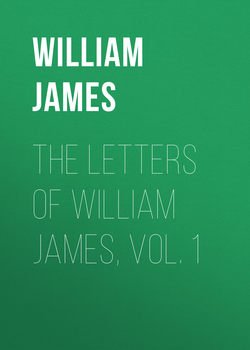Читать книгу The Letters of William James, Vol. 1 - William James - Страница 5
II
1861-1864
ОглавлениеChemistry and Comparative Anatomy in the Lawrence Scientific School
IN the autumn of 1861 James turned to scientific work, and began what was to become a lifelong connection with Cambridge and Harvard University by registering for the study of chemistry in the Lawrence Scientific School. Among the students who were in the School in his time were several who were to be his friends and colleagues in later years—Nathaniel S. Shaler, later Professor of Geology and Dean of the Scientific School, Alexander Agassiz, engineer, captain of industry, eminent biologist, and organizer of the museum that his father had founded, the entomologist Samuel H. Scudder, F. W. Putnam, who afterwards became Curator of the Peabody Museum of Ethnology and Anthropology, and Alpheus Hyatt, the palæontologist, who was Curator of the Museum of Comparative Zoölogy at Harvard for many years before his death in 1902. The chemical laboratory of the school had just been placed under the charge of Charles W. Eliot,—in 1869 to become President Eliot,—who writes: "I first came in contact with William James in the academic year 1861-62. As I was young and inexperienced, it was fortunate for me that there were but fifteen students of chemistry in the Scientific School that year, and that I was therefore able to devote a good deal of attention to the laboratory work of each student. The instruction was given chiefly in the laboratory and was therefore individual. James was a very interesting and agreeable pupil, but was not wholly devoted to the study of Chemistry. During the two years in which he was registered as a student in Chemistry, his work was much interfered with by ill-health, or rather by something which I imagined to be a delicacy of nervous constitution. His excursions into other sciences and realms of thought were not infrequent; his mind was excursive, and he liked experimenting, particularly novel experimenting.... I received a distinct impression that he possessed unusual mental powers, remarkable spirituality, and great personal charm.19 This impression became later useful to Harvard University."
Henry James published many of the few still existing letters which William wrote during this time in his "Notes of a Son and Brother." Three of them are among the first six selected for inclusion here. The fun and extravagance of these early letters is so full of an intimate raillery that they should be read in their context in that book, where the whole family has been made to live again. The first of the letters that follow was written a few weeks after the opening of the autumn term in which James began his course in chemistry. The son of Professor Benjamin Peirce (the mathematician) of whom it makes mention was the brilliant but erratic Charles S. Peirce, to whom other references appear in later letters, and whose name James subsequently associated with his pragmatism. "Harry," "Wilky" and "Bobby" will be recognized as William's younger brothers. Wilky was at the Sanborn School in Concord, thirteen miles away. Bobby was in Newport, under the parental roof at 13 Kay Street. The Emerson referred to was R. W. Emerson's son, Edward W. Emerson, and "Tom" Ward, the Thomas W. Ward of a lifelong friendship and of several later letters and allusions.
19
The following entries occur among some "notes on his students" which President Eliot made at the time—
